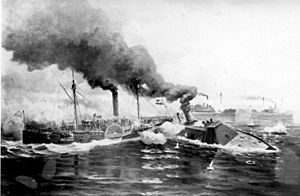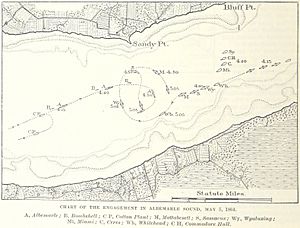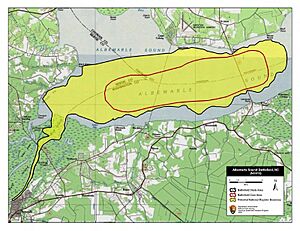Battle of Albemarle Sound facts for kids
Quick facts for kids Battle of Albemarle Sound |
|||||||
|---|---|---|---|---|---|---|---|
| Part of the American Civil War | |||||||
 USS Sassacus ramming CSS Albemarle |
|||||||
|
|||||||
| Belligerents | |||||||
| Commanders and leaders | |||||||
| Strength | |||||||
| 8 gunboats | 1 ironclad 2 steamers |
||||||
| Casualties and losses | |||||||
| 31 killed or wounded | 57 killed or wounded | ||||||
The Battle of Albemarle Sound was a naval battle that happened in May 1864. It took place along the coast of North Carolina during the American Civil War. In this battle, three Confederate warships fought against eight Union gunboats. One of the Confederate ships was a strong ironclad. The fight ended without a clear winner when the sun went down.
Contents
Why the Battle Happened
In April 1864, a Confederate Army, helped by the powerful ship CSS Albemarle, made the Union soldiers at Plymouth surrender. Robert Hoke, a Confederate Army commander, was very happy about this win. He then wanted to take back New Bern. New Bern had been controlled by the Union since early 1862. For his plan to attack New Bern, Hoke again asked for help from the Albemarle. This ship had been key to winning the Battle of Plymouth.
The Battle Begins
James W. Cooke, who commanded the Albemarle, sailed out of Plymouth in early May 1864. He was joined by two other ships: the captured steamer CSS Bombshell and the transport ship CSS Cotton Plant. As they sailed south towards New Bern, Cooke's ships met a Union fleet. This Union fleet was at the entrance of Albemarle Sound. Captain Melancton Smith led the Union ships.
The Union fleet included several gunboats: USS Mattabasett, USS Sassacus, USS Wyalusing, and USS Miami. There were also the converted ferryboat USS Commodore Hull, USS Ceres, USS Whitehead, and USS Isaac N. Seymour.
When the Confederate ships were seen, the Union ships Mattabasett, Sassucus, Whitehead, and Wyalusing quickly got into a battle line. The Miami, Commodore Hull, and Ceres supported them.
Fighting on the Water
The Albemarle fired first. Its shot wounded six men on the Mattabesett. Then, Mattabesset, Whitehead, and Wyalusing all fired back at almost the same time. The Albemarle tried to ram the Mattabesett. But the Mattabesett, a sidewheeler, was able to move around the ironclad's strong front.
The Sassacus followed closely behind. It fired a powerful shot of solid 9 in (229 mm) and 100-pound cannonballs. All of these bounced off the Albemarle's armored sides. However, the Bombshell was not as strong. It was hit by every heavy shot from the Sassucus and had to surrender. The Cotton Plant quickly sailed back up the Roanoke River. The Albemarle was left to fight alone.
Captain Smith, even with more ships, found it hard to damage the single Confederate ship. Shots just bounced off the Albemarle's sides. Lieutenant Commander Francis Asbury Roe of the Sassucus saw the Albemarle about 400 yards (370 m) away. He decided to ram it.
The Union ship hit the Confederate ironclad directly on its side. This crash broke the front of the Sassucus and twisted off its own bronze ram. The two ships got stuck together. The Sassucus's hull was almost touching the Albemarle's gun. The Albemarle's crew quickly fired two shells from very close range. One of them broke the Sassucus's boilers. Hot steam filled the ship, but it managed to break free and drift away. The Sassacus was too damaged to keep fighting and floated down the river.
The Miami tried to use a spar torpedo to blow up the Albemarle. Then it tried to tangle the Confederate ship's propellers and steering with a large seine net. Neither of these plans worked.
The Mattabasett and Wyalusing kept fighting the Albemarle for three hours. The battle stopped when it got dark. More than 500 shells were fired at the Albemarle during the fight. Even with some damage to its smokestack and other parts, the ironclad sailed back up the Roanoke River. The Commodore Hull and Ceres moved to the river's mouth. They tried to stop the Albemarle from coming back into the sound.
What Happened Next
The battle itself ended in a tie. But what happened after had bigger results. The Albemarle had held its own against more ships. However, the damage it took in the battle forced the ship to stay in port for several months. This stopped it from being used in General Hoke's plan to attack New Bern.
Hoke went ahead with his campaign even without the Albemarle. He didn't achieve anything important before being called back to Virginia to help defend Petersburg and Richmond.
Events in October had a greater impact. William B. Cushing led a naval raid and set off a torpedo under the Albemarle's hull. This destroyed the ship. With Hoke's forces gone and the Albemarle destroyed, both Plymouth and Washington, North Carolina, fell back into Union control.
Ships in the Battle
Captain Melancton Smith
- USS Commodore Hull
- USS Ceres
- USS Miami
- USS Wyalusing
- USS Sassacus - flagship (main ship)
- USS Mattabesett
- USS Whitehead
- USS Isaac N. Seymour
- Ida May (transport ship)
Confederate Mosquito Fleet
Commander James W. Cooke
- CSS Albemarle
- CSS Bombshell
- CSS Cotton Plant



